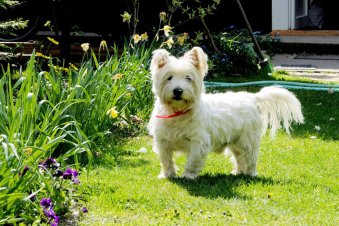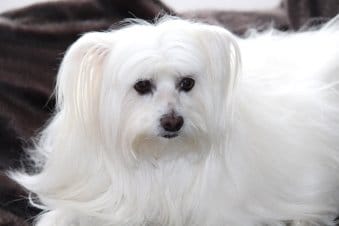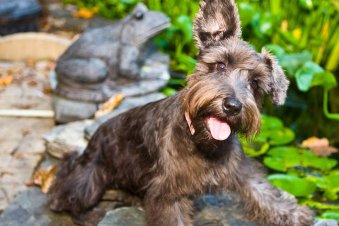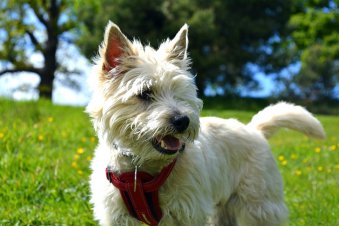Are West Highland White Terriers Hypoallergenic?
Yes! The West Highland White Terrier is a small hypoallergenic dog breed that hardly sheds or drools.
The West Highland White Terrier is a short-legged terrier that was originally bred in Scotland and is closely related to the Cairn Terrier, the Skye Terrier, and the Scottish Terrier. This group of low slung terriers were bred to hunt in the rough terrain and harsh climate of Scotland. Their short legs helped them to squeeze into difficult to reach places, and made them better able to navigate rocky areas with loose footing.
It is said that the West Highland White Terrier was bred to come in white, only, because it made the dog easier to distinguish from its quarry, so hunting accidents were less common. Their rough outer coat protects them from harsh weather, while they’re soft inner coat keeps them warm. Westies are considered hypoallergenic, as their coat rarely sheds, and they are low dander dogs. These dogs have unusually thick and sturdy tail bases that allow them to be pulled out of a hole by their tails without pain if they get stuck while chasing prey.
For a quick summary of the West Highland White Terrier skip to our West Highland White Terrier dog breed summary further down the page.
View more Hypoallergenic Dog Breeds
Are West Highland White Terriers Hypoallergenic Dogs? Contents
West Highland White Terrier Quick Facts
About the Breed
West Highland White Terrier Training and Exercise
West Highland White Terrier Grooming and Care
Health
Conclusion
West Highland White Terrier FAQ
West Highland White Terrier Facts Summary

West Highland White Terrier Quick Facts
| Hypoallergenic Dog: | Yes! |
| Shedding: | Low shedding |
| Drooling: | Low |
| Size: | Small |
| Breed Group: | Terrier |
| Lifespan: | 12 – 16 years |
| Energy Level: | High |
| Trainability: | Medium |
| Family Dog: | Yes |
About the Breed
The West Highland White Terrier Physical Characteristics and Coat
The stout Westie has black beady eyes and a button nose. The hair around their nose fluffs out like a moustache, and their short, pointy ears give their face an overall foxy appearance. These dogs have thick, sturdy legs with feet that point slightly inward, which helps them to keep their footing on loose ground. Their tails are thick at the base and taper off to a pointed tip.
The West Highland Terrier’s coat is a hypoallergenic double coat that is made up of a coarse outer coat, and a soft undercoat. They shed very little and have low dander levels. Regular brushing can further reduce any allergens in their coat and remove any dander and loose hairs that have been caught in their outer coat.
West Highland White Terrier Temperament
Temperament in the Westies varies greatly from dog to dog. Many are quite friendly and sociable, even towards children, but there are some that prefer their solitude. These dogs, like most terriers, should be monitored around children. Terriers are well known for delivering sharp reprimands to dogs or small children that play too roughly. Westies can be quite stubborn. That can make training difficult. They do, however, respond well when motivated with toys.
This breed is self-assured and independent. They are- loving, loyal family members that will take it upon themselves to keep watch, and sound the alarm if needed. West Highland White Terriers are also quite energetic and nearly always on the move. They need a time and space to sniff, explore, and discover new things, so they do best with a decently sized, securely fenced in back yard. It’s important to keep Westies leashed when you walk them. The prey drive in these small dogs is vey high, and they are likely to dash after small animals with surprising speed and a complete lack of consideration for whatever you happen to be saying at the time.
What should I feed my West Highland White Terrier?
There’s a lot of debate out there as to whether you should feed your dog regular dog food, or if you should make your own food from scratch. I give my dog both regular dog food, and some extra healthy stuff. This book is a great resource. Check it out here!
Are you considering adopting an Westie?
- Here’s what to watch out for :
- Westies are full of energy and have a very high prey drive, so it’s important to keep them leashed when you’re in an area that’s not enclosed.
- They are very friendly, but care should be taken around cats, small children, and dogs that play rough.
- These dogs are great watch dogs, but they can tend to bark too much.
- They are easy to groom, but they can have a lot of skin issues.
- While Westies are very intelligent, they can also be very stubborn and difficult to train.
Take a humorous look at the Westie Temperament here: Dear Santa … from a West Highland White Terrier
West Highland White Terrier Training and Exercise
Encouraging Good Behavior In Your West Highland White Terrier
Training your Westie can be a challenge. These dogs are very spirited and can be very stubborn when they want to be. The best approach to training a terrier is to make training sessions fun! Terriers are very toy motivated, so find a game that they like best, and reward them with it. Training sessions should be kept short – about ten minutes is good, and you should remain upbeat and positive. It is important to begin training from the first day you get your puppy home! Establish rules and boundaries, and stick to them, because Westies are much more likely to listen at this age.
One of the best tricks your can teach your little white terrier, ironically, is how to bark. They are very good at it, and very intelligent, so with the right motivation they should catch on quickly! Once your Westie knows how to bark on command, you can then teach them NOT to bark. This will cut down immensely on unnecessary and annoying barking!
Exercise Needs
Westies are very active dogs and most owners choose to walk them 2-3 times a day. About 40 minutes of daily exercise is a good amount for these terriers. It helps to have a yard that they can run and play in, because they are very curious and love to seek, sniff, and discover. Having the opportunity to explore off leash is good exercise for their busy minds. Training them to do tricks is also a good way to tire out your Westie mentally, but be sure to keep training sessions short (about 10 minutes) and upbeat.
Smart dogs behave better.
Training your Westie can cut down on a lot of their negative behaviors. My favorite dog training resource is Brain Training for Dogs. It’s easy to follow, and it’s fun to do. Check it out here!
West Highland White Terrier Grooming and Care
Maintaining Your West Highland White Terrier’s Coat
(Skip this section)
Grooming a West Highland White Terrier is not too difficult or time consuming. It’s better to brush them every few days rather than to let the coat go, because its easier for you, and less uncomfortable for your dog. Frequent brushing stimulates natural skin oil production which keeps your Westie’s skin and coat healthy. It also gives you the opportunity to feel for any lumps, bumps, or lesions that could indicate an underlying health issue.
These low-shedding dogs require little in the way of bathing. Their harsher outer coat actually traps and releases dirt and debris so they are cleaner than most dogs. Hypoallergenic qualities like not shedding much and producing less dander often go hand in hand with dogs that produce very little odor, like Westies. Overbathing your dog can be bad for their skin, so unless your little terrier is really dirty, grooming wipes or even baby wipes are a good option to maintain their cleanliness so you can bathe them less frequently.
Teeth, Ears and Nails
You should check your pup’s ears when you brush them. Look out for redness or wax build up, and clean them with a cleanser and a cotton ball, or use a half and half ratio of vinegar and water. If you do notice a strange odor coming from your Westie, a yeast or bacterial infection in their ears could be the culprit.
Maintain your pooch’s pearly smile by brushing their teeth 1-2 times a week. Teeth brushing treats can help some, but veterinarians agree that they are no substitute for a real toothbrush. Most dogs develop periodontal disease as they get older, which can be very uncomfortable, and cause them to loose teeth in their older age which makes it difficult for them to chew their food. Dental problems are also very expensive, so proper oral hygiene now is key to having a healthy older dog who won’t break the bank. Some dogs will wear their toenails down naturally, but if yours is the sort that doesn’t, you should trim their nails twice a month. Dogs that have their nails go untrimmed grow long quicks (the living part of the nail), which makes it harder to cut the nails without them bleeding. Luckily, even if your dog does have long quicks, regular nail trimming can shorten them.
Health
West Highland White Terrier Health Issues and Care
Like any dog, Westies are prone to a few health problems that any aspiring owner should be aware of. Craniomandibular osteopathy or “lion jaw” is a disease where the bones of the jaw thicken, and it can make it difficult for your dog to eat or swallow. Usually it appears in dogs that are under a year old and stops progressing, or even recedes, as they get older. Radiographic testing and blood tests can reveal the problem, at which point veterinarians may prescribe anti-inflammatory medication to stop it from getting worse. However, in severe cases, a dog may be in chronic pain and be unable to eat, in which case euthanasia is the most humane option.
These terriers are often known to develop skin disorders that may masquerade initially as allergies. Atopic dermatitis and Hyperplastic dermatosis can be difficult to diagnose, but if you suspect your dog may have chronic allergies, you should keep a diary of their symptoms and the conditions in which they appear.
A serious issue to be aware of is White Dog Shaker Syndrome, a condition that can manifest in 1-3 days and includes seizures, uncoordinated movement, tremors, difficulty walking, and paralysis. Many dogs can recover after several months of medication, but some dogs will need to take low doses of medication for the rest of their lives.
West Highland White Terrier Health Problems
- Allergies
- Atopic dermatitis
- Hyperplastic dermatosis
- Cataracts
- Colitis
- Copper Toxicosis
- Hip Dysplasia
- Keratoconjunctivitis Sicca
- Legg-Calve-Perthes disease
- Pancreatitis
- Patellar Luxation
- Pulmonary Fibrosis
- White Shaker Dog Syndrome

Conclusion
West Highland White Terriers are notoriously cheery, happy-go-lucky, playful dogs. Their spirited personalities are undaunted by age, and they are sure to make you laugh with their hilarious antics. These little terriers are a joy to own. They are naturally friendly to other dogs and people, but they are not as patient with small children, and they may be prey driven to chase cats or other uncaged small animals. While they aren’t much trouble to groom, they do require more exercise than their small stature might suggest. Not only do they require a good bit of physical exercise (about 40 minutes a day), they also need ample opportunities to exercise their minds. A decently sized, securely enclosed backyard can help your Westie fulfill their urge to explore.
Luckily, these little dogs require little grooming! They are light shedders that have hardly any odor, and their coarse outer coat helps to keep them clean. A simple wipe down with a baby wipe can keep your Westie crisp and fresh! Don’t forget to brush them at least a couple of times a week to keep your West Highland White Terrier hypoallergenic.
West Highland White Terrier FAQ
Do Westies Shed?
Westies shed a little. A lot of their hair gets stuck in their outer coat, so if you brush them a few times a week, not much of their hair makes it onto your furniture or clothes.
Do Westies Like Water?
A lot of Westies enjoy water, but it depends on the dog.
Do Westies Bark a Lot?
Yes! Most Westies bark quite a bit. They are protective of their homes and their families.
Do Westies Have Hair or Fur?
Hair. However, the difference between “hair” and “fur” is largely semantic. They are chemically the same. Usually people refer to “hair” as the kind of coat that grows continuously until it is very long, and often needs to be trimmed, much like the hair on top of your head. The term “fur” is used to describe coats that grow to a certain length and stop, shed more, and don’t need to be trimmed – like Labs. In this sense, Westies have hair, not fur.
Do Westies Get Along with Cats?
Sometimes. Westies are usually pretty good about getting along with cats they grow up with, but for the most part, they can be pretty big into cat chasing.
Are Westies Smart?
Yes!
Are Westies Hard to Train?
They can be fairly stubborn and training should start from an early age.
Are Westies Hypoallergenic?
Yes!
Is the Westie Right for Me?
West Highland White Terriers are very energetic dogs that require a lot of exercise. As small dogs, they have smaller bladders. They also don’t like being left alone. If you don’t have time to exercise them properly, or you expect to crate them for more than 4 hours a day, a Westie may not be a good dog for you.
West Highland White Terrier Facts Summary
| Breed | West Highland White Terrier |
| Other Names? | Poltalloch Terrier Roseneath Terrier White Roseneath Terrier Westie |
| Hypoallergenic? | Yes |
| Height | Female : 23-28 cm (9 – 11 in) Male : 25–30 cm (10 – 12 in) |
| Weight | Female: 13–15 lbs (6–7 kg) Male: 15–22 lbs (7–10 kg) |
| Lifespan | 12 – 16 years |
| Temperament | Hardy, Friendly, Alert, Independent, Happy, Active, Courageous |
| Colours | White |
| Coat – describe the coat | Double layered with a harsh outer coat that gets wavy as it grows out, and a soft undercoat. |
| How much grooming? | Average |
| How much shedding | Light |
| Dander levels | Low dander level |
| Saliva – Do they Drool or Lick much? | Low |
| Energy levels | High |
| How much exercise do they need? | 40 minutes daily |
| Health problems | Allergies, Atopic dermatitis, Hyperplastic dermatosis, Cataracts, colitis, copper toxicosis, Hip Dysplasia, Keratoconjunctivitis Sicca, Legg-Calve-Perthes disease, patellar luxation, Pulmonary fibrosis, White Shaker Dog Syndrome |
| Good for apartment? | Yes – but they bark a lot |
| Suitable for kids? | Yes – but monitor them with small children |
| How much do they bark? | Quite a bit |
| Can they be left alone? | Not for long periods of time |
| Intelligent? | Yes |
| Trainable? | Yes, but they can be stubborn |
| How popular as a pet? | Unusual, AKC ranks them 41/194 |
| Any other important facts? | West Highland White Terriers belong to a group of short-legged terriers that were bred in Scotland such as the Cairn Terrier and the Scottish Terrier. Their short stature allows them to enter animal dens from quarry such as foxes and badgers. |










 </a
</a

